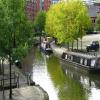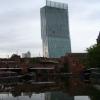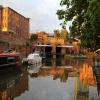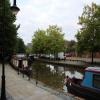
Grocer's Wharf 

Mooring here is good (a nice place to moor), mooring rings or bollards are available. Mooring is limited to 48 hours.
You can wind here.
| Grocer's Wharf | ||
| Castle Quay Arm | ½ furlongs | |
| Merchants Warehouse | ¾ furlongs | |
| Castlefield Junction | ¾ furlongs | |
| Merchants Footbridge No 100B | 1 furlong | |
| Staffordshire, Kenworthy and other Arms | 1 furlong | |
Amenities here
Why not log in and add some (select "External websites" from the menu (sometimes this is under "Edit"))?
Mouseover for more information or show routes to facility
Nearest water point
In the direction of Waterloo Bridge (Runcorn)
Nearest rubbish disposal
In the direction of Waterloo Bridge (Runcorn)
Nearest chemical toilet disposal
In the direction of Waterloo Bridge (Runcorn)
Nearest place to turn
In the direction of Waterloo Bridge (Runcorn)
Nearest self-operated pump-out
In the direction of Waterloo Bridge (Runcorn)
Nearest boatyard pump-out
In the direction of Waterloo Bridge (Runcorn)
In to Manchester from Scribblings from the Mintball posted Monday the 19th of September, 2016
Wikipedia has a page about Grocer's Wharf
A grocery store (North America), grocer or grocery shop (UK), is a store primarily engaged in retailing a general range of food products, which may be fresh or packaged. In everyday U.S. usage, however, "grocery store" is a synonym for supermarket, and is not used to refer to other types of stores that sell groceries. In the UK, shops that sell food are distinguished as grocers or grocery shops, though in everyday use, people usually use either the term "supermarket" or, for a smaller type of store that sells groceries, a "corner shop" or "convenience shop".
Larger types of stores that sell groceries, such as supermarkets and hypermarkets, usually stock significant amounts of non-food products, such as clothing and household items. Small grocery stores that mainly sell fruits and vegetables are known as greengrocers (Britain) or produce markets (U.S.), and small grocery stores that predominantly sell prepared food, such as candy and snacks, are known as convenience shops or delicatessens.
Some groceries specialize in the foods of certain countries or regions, such as Chinese, Italian, Middle Eastern, or Polish. These stores are known in the U.S. as ethnic markets and may also serve as gathering places for immigrants.












![Boat Dog. Happily wandering round on the upper deck of [[5405306]] by Bob Harvey – 21 May 2017](https://s2.geograph.org.uk/geophotos/05/40/53/5405310_036493f9_120x120.jpg)






![Lettering on narrow boat. Detail of [[5402384]] by Bob Harvey – 21 May 2017](https://s1.geograph.org.uk/geophotos/05/40/23/5402389_d7378d09_120x120.jpg)








![Castlefield Canal Basin. An evening view of the Bridgewater Canal at Castlefield Basin. Notice the illuminated tower of the grade II-listed, former Congregational Chapel [[[3119686]]] in the left hand corner of the photograph. by David Dixon – 03 July 2014](https://s2.geograph.org.uk/geophotos/04/06/05/4060594_5eccd720_120x120.jpg)



![Blue Moon at Castlefield. In the background is the former Castlefield Congregational Church [[3836217]] and to the left is the Beetham Tower. by Gerald England – 19 June 2018](https://s1.geograph.org.uk/geophotos/05/94/78/5947853_0ce37154_120x120.jpg)

![The Grocers' Warehouse, Castlefield Basin. The opening of the Bridgewater Canal in 1764 meant that coal, from the mines at Worsley, could be brought into Manchester by barge. Manchester’s new industries now had a cheap supply of coal to fuel the Industrial Revolution. The Grocer’s warehouse built in the early 1770s, next to the coal wharf, was one of first large warehouses at Castlefield. In 1811, it was sold to the Manchester Grocers’ company and that is how it got its name.The warehouse was five storeys high and had five window bays facing the canal and a single entrance, two storeys high. Boats entered here for unloading at the internal dock where there was a water-powered hoist (it was probably the first British warehouse where the barges were unloaded inside the building by a water-powered crane). The original building was demolished in 1960 and a partial reconstruction, which incorporated a water wheel driven hoist, was completed in 1967. This reconstruction (beyond the metal footbridge in the picture) shows the first level of the warehouse and the barge entrance with the hoist inside.The Grocers’ warehouse is commemorated a cog wheel which bears this inscription in the centre:“Built on the site where coal was first brought to Manchester by canal for the 1st Duke of Bridgewater. The warehouse marks the location where coal was transferred to street level using water wheel driven machinery designed and built by James Brindley. The delivery of cheap coal marked the beginning of the Industrial Revolution and helped establish Manchester as a principal manufacturing centre.As a result of increasing trade and success of the scheme a warehouse for the storage of provisions was constructed on the site of the coal wharfâ€.[[[3119640]]] by David Dixon – 02 January 2015](https://s3.geograph.org.uk/geophotos/04/29/86/4298683_97b257a6_120x120.jpg)



![The Grocers’ Warehouse Cogwheel. The Grocers’ warehouse built in the early 1770s, next to the coal wharf, was one of the first large warehouses at Castlefield. It was probably the first British warehouse where the barges were unloaded inside the building by a water-powered crane. In 1811, it was sold to the Manchester Grocers’ company and that is how it got its name. The original building was demolished in 1960 and a partial reconstruction, which incorporated a water wheel driven hoist, was completed in 1967. The Grocers’ warehouse is commemorated by this waterwheel which bears the inscription:“Built on the site where coal was first brought to Manchester by canal for the 1st Duke of Bridgewater. The warehouse marks the location where coal was transferred to street level using water wheel driven machinery designed and built by James Brindley. The delivery of cheap coal marked the beginning of the Industrial Revolution and helped establish Manchester as a principal manufacturing centre.As a result of increasing trade and success of the scheme a warehouse for the storage of provisions was constructed on the site of the coal wharf.â€[[[3119640]]] by David Dixon – 03 September 2012](https://s3.geograph.org.uk/geophotos/06/96/63/6966307_6404ec74_120x120.jpg)
![Grocers’ Warehouse Cogwheel and Deansgate South Tower. Looking through the cogwheel towards the recently-built high rise buildings on the other side of the Castlefield Basin. Including the South Tower at Deansgate Square which was completed in 2018 and is currently the tallest building in Manchester. Compare this view with [[[6966307]]], taken in 2012.The Grocers’ warehouse built in the early 1770s, next to the coal wharf, was one of the first large warehouses at Castlefield. It was probably the first British warehouse where the barges were unloaded inside the building by a water-powered crane. In 1811, it was sold to the Manchester Grocers’ company and that is how it got its name. The original building was demolished in 1960 and a partial reconstruction, which incorporated a water wheel driven hoist, was completed in 1967. The Grocers’ warehouse is commemorated by this waterwheel which bears the inscription:“Built on the site where coal was first brought to Manchester by canal for the 1st Duke of Bridgewater. The warehouse marks the location where coal was transferred to street level using water wheel driven machinery designed and built by James Brindley. The delivery of cheap coal marked the beginning of the Industrial Revolution and helped establish Manchester as a principal manufacturing centre.As a result of increasing trade and success of the scheme a warehouse for the storage of provisions was constructed on the site of the coal wharf.â€[[[3119640]]] by David Dixon – 15 September 2021](https://s0.geograph.org.uk/geophotos/06/96/63/6966300_8e2b8ac2_120x120.jpg)
![Bridgewater Canal, Grocers' Warehouse. The opening of the Bridgewater Canal in 1764 meant that coal, from the mines at Worsley, could be brought into Manchester by barge. Manchester’s new industries now had a cheap supply of coal to fuel the Industrial Revolution. The Grocer’s warehouse built in the early 1770s, next to the coal wharf, was one of first large warehouses at Castlefield. In 1811, it was sold to the Manchester Grocers’ company and that is how it got its name.The warehouse was five storeys high and had five window bays facing the canal and a single entrance, two storeys high. Boats entered here for unloading at the internal dock where there was a water-powered hoist (it was probably the first British warehouse where the barges were unloaded inside the building by a water-powered crane). The original building was demolished in 1960 and a partial reconstruction, which incorporated a water wheel driven hoist, was completed in 1967. This reconstruction (beyond the narrowboat and the black footbridge in the picture) shows the first level of the warehouse and the barge entrance with the hoist inside.The Grocers’ warehouse is commemorated a cog wheel which bears this inscription in the centre:“Built on the site where coal was first brought to Manchester by canal for the 1st Duke of Bridgewater. The warehouse marks the location where coal was transferred to street level using water wheel driven machinery designed and built by James Brindley. The delivery of cheap coal marked the beginning of the Industrial Revolution and helped establish Manchester as a principal manufacturing centre.As a result of increasing trade and success of the scheme a warehouse for the storage of provisions was constructed on the site of the coal wharfâ€.[[[3119640]]] by David Dixon – 03 September 2012](https://s3.geograph.org.uk/geophotos/03/11/97/3119707_ac8b111e_120x120.jpg)